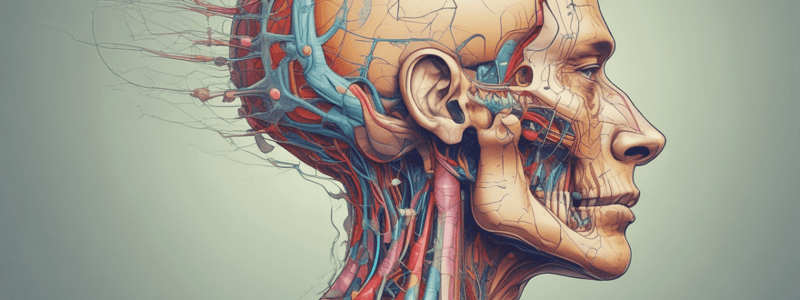Podcast
Questions and Answers
Which of the following statements accurately describes the role of the cerebral cortex in the nervous system?
Which of the following statements accurately describes the role of the cerebral cortex in the nervous system?
- The cerebral cortex is the initial point of reception for all sensory information.
- The cerebral cortex is solely responsible for regulating involuntary bodily functions.
- The cerebral cortex is responsible for processing and interpreting sensory information. (correct)
- The cerebral cortex is the primary site for initiating and controlling voluntary movements.
Which of the following correctly identifies the type of impulses that are received by the spinal nerves?
Which of the following correctly identifies the type of impulses that are received by the spinal nerves?
- Efferent impulses, which carry sensory information.
- Efferent impulses, which control movement.
- Afferent impulses, which control movement.
- Afferent impulses, which carry sensory information. (correct)
What is the primary function of the peripheral nervous system?
What is the primary function of the peripheral nervous system?
- To control voluntary and involuntary muscle movements.
- To regulate internal bodily functions, such as breathing and heart rate.
- To relay information between the brain and spinal cord and the rest of the body. (correct)
- To process and interpret information from the environment.
Which of the following is NOT a component of the peripheral nervous system?
Which of the following is NOT a component of the peripheral nervous system?
What is the main difference between afferent and efferent impulses?
What is the main difference between afferent and efferent impulses?
What is the primary role of the sympathetic and parasympathetic systems in the body?
What is the primary role of the sympathetic and parasympathetic systems in the body?
Which cranial nerve is responsible for transmitting sensory information related to balance and hearing?
Which cranial nerve is responsible for transmitting sensory information related to balance and hearing?
Which lobe of the brain is responsible for visual processing?
Which lobe of the brain is responsible for visual processing?
Which of the following correctly describes the organization of the Nervous System?
Which of the following correctly describes the organization of the Nervous System?
What is the primary function of the glossopharyngeal nerve?
What is the primary function of the glossopharyngeal nerve?
Which of the following functions is NOT associated with the temporal lobe?
Which of the following functions is NOT associated with the temporal lobe?
Which of the following statements best defines homeostasis?
Which of the following statements best defines homeostasis?
Which of the following is NOT a function of the vestibulocochlear nerve?
Which of the following is NOT a function of the vestibulocochlear nerve?
Which lobe is responsible for integrating sensory information?
Which lobe is responsible for integrating sensory information?
What does the autonomic nervous system primarily innervate?
What does the autonomic nervous system primarily innervate?
In what way do the sympathetic and parasympathetic systems contribute to bodily functions?
In what way do the sympathetic and parasympathetic systems contribute to bodily functions?
What is the function of the motor fibers in the glossopharyngeal nerve?
What is the function of the motor fibers in the glossopharyngeal nerve?
Which of the following is NOT a function of the frontal lobe?
Which of the following is NOT a function of the frontal lobe?
Which cranial nerve is not mentioned in the given content?
Which cranial nerve is not mentioned in the given content?
The ability to make a drawing on your hand is primarily related to which lobe of the brain?
The ability to make a drawing on your hand is primarily related to which lobe of the brain?
What structure connects the two halves of the brain?
What structure connects the two halves of the brain?
What is the primary function of the corpus callosum?
What is the primary function of the corpus callosum?
Which statement is true regarding the corpus callosum?
Which statement is true regarding the corpus callosum?
The connection between the cerebral hemispheres primarily facilitates what process?
The connection between the cerebral hemispheres primarily facilitates what process?
Which of the following best describes the placement of the corpus callosum?
Which of the following best describes the placement of the corpus callosum?
Flashcards are hidden until you start studying
Study Notes
Organization of the Nervous System
- The Nervous System supplies the body wall and limbs (Somatic) and the Viscera (autonomic).
Types of Nerves
- Vestibulocochlear nerve: sensory for balance and hearing
- Glossopharyngeal nerve (IX): sensory for taste; motor fibers to the pharynx
- Cranial nerves: 12 pairs
- Spinal nerves: 31 pairs
Central Nervous System
- Consists of the brain and spinal cord
- Brain parts:
- Hemisphere: left and right halves of the brain
- Corpus callosum: connects the two halves of the brain, delivers messages between them
- Brain lobes:
- Frontal: voluntary motor functions, planning, mood, smell, and social judgement
- Parietal: sensory reception and integration of sensory information
- Occipital: visual processing
- Temporal: hearing, smell, learning, memory, and emotional behavior
Functions of Nerves
- Sympathetic and parasympathetic systems innervate many organs of the body, serving to balance functioning to maintain homeostasis
Neural Impulses
- Afferent impulses (sensation): received from the body by the spinal nerves and sent to the cerebral cortex
- Efferent impulses (movement): sent to the body by the spinal nerves and received from the cerebral cortex
Studying That Suits You
Use AI to generate personalized quizzes and flashcards to suit your learning preferences.




